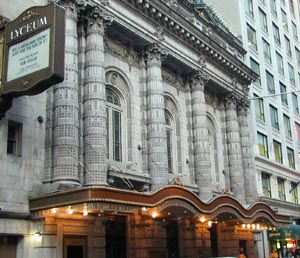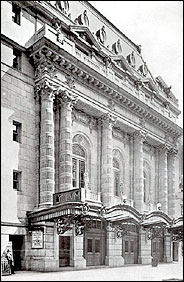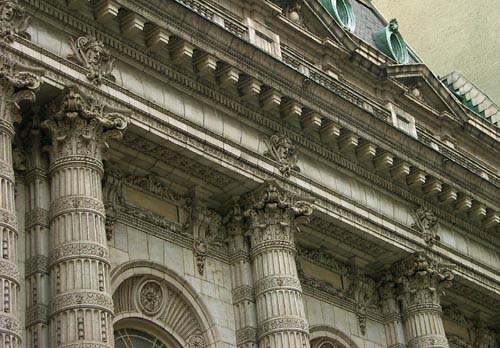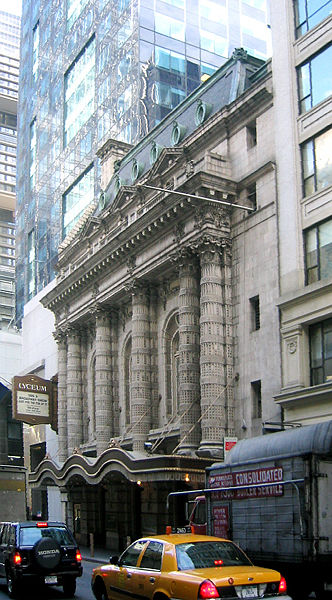 |
New York Architecture Images- Midtown Lyceum Theater Landmark |
|
architect |
Herts & Tallant |
|
location |
149-157 W45, bet. Sixth Ave and Broadway. |
|
date |
1903 |
|
style |
Beaux-Arts |
|
construction |
stone |
|
type |
Theater |
|
images |
  |
|
|
 |
  |
|
|
The Lyceum Theatre is a legitimate Broadway theatre located at 149 West
45th Street in midtown-Manhattan. It has the distinction of being the oldest surviving Broadway venue (along with the New Amsterdam Theatre), the oldest continuously operating legitimate theatre in New York City, and the first Broadway theatre ever to be granted landmark status (1974). It is one of the few theatres in New York to operate under its original name. Designed by architects Herts & Tallant, the Lyceum was built by impresario Daniel Frohman, whose brother Charles served as manager until his death in 1915. It opened on November 2, 1903 with the play The Proud Prince. Among the prominent performers who appeared on its stage in the theatre's early years were Ethel Barrymore, Billie Burke, Basil Rathbone, Fanny Brice, Walter Huston, Miriam Hopkins, and Cornelia Otis Skinner. The theatre maintains most of its original Beaux-Arts design, including its elaborate marble staircases and undulating marquee. Although it has three levels, it is one of the smallest Broadway theatres in terms of capacity, seating only 950. An apartment located above the orchestra, originally used by Frohman, is now the headquarters of the Shubert Archives. |
|
|
The works with double terra cotta
Both the Lyceum theater (shown here) and the New Amsterdam (renovated by Disney and reopened to show "The Lion King") originally opened in 1903, were designed by the architectural team of Herts & Tallant, and have achieved Landmark status (nice going, H & T!). Behind the balcony was a penthouse apartment for the producer, and behind the round windows above that was a rehearsal hall. The square boxes directly above the columns originally held (literally) "flaming tripods". The blank rectangles between the columns originally had more ornate carvings which it would be nice to see replaced! |
|
|
Producer Daniel Frohman was one of the first Broadway impresarios to follow Oscar Hammerstein north of 42nd Street. As such, his Lyceum Theater is the oldest continuously-operating legitimate theater on Broadway. The Lyceum's mansard-topped, elaborately-columned, Baroquely ornamented Beaux-Arts facade—fronted by a waving marquee—encloses a small and intimate and elaborately decorated landmarked interior. The walls and ceiling are lavishly plastered and painted and include murals, marble panels and bronze statues. The house interior is illuminated by hundreds of electric bulbs. Though this theater embodies many 19th-century theater design principles—two balconies, performer's green room, producer's apartment—Herts & Tallant included the first cantilevered balcony on Broadway, eliminating columns that obscured views from the orchestra The Lyceum's premier show was a performance of Proud Prince on November 2, 1903. Both Frohman and his theater fell on hard times during the depression, the theater's career managed to always survive as a legitimate Broadway venue 1905 586 performances were very rare in the '00s, but that's how long Charles Klein's drama The Lion and the Mouse remains on the boards. It stars Richard Bennett 1909 Walter Hampden and Lucille Watson star in Clyde Fitch's drama The City 1914 Florenz Ziegfeld produces the comedy Jerry. Billie Burke stars. On Apr 11 1914 Ziegfeld and Burke are married in between matinee and evening performances of the show 1917 Willard Mack's Tiger Rose stars the author and Lenore Ulric. Also in the cast are Pedro De Cordoba and Calvin Thomas 1919 Ina Claire and Pauline are The Gold Diggers, Avery Hopwood's 700-performance hit comedy 1926 Fanny Brice can do vaudeville. Fanny Brice can do musicals. Fanny Brice can do comedy. Produces David Belasco and Willard Mack bet their money that Fanny Brice can do drama. She can't. Fanny closes after 63 tries 1929 At least Leslie Howard still has money after Black Monday. And he's still starring in his own shows, this time in John Lloyd Balderston's drama Berkeley Square 1931 It only runs for 70 performances, but Payment Deferred stars Elsa Lancaster and marks Charles Laughton's Broadway debut 1933 Audrey Christie stars opposite Brice McFarlane in the Kenyon Nicholson-Charles Robinson comedy Sailor Beware! 1937 John Garfield, Katherine Locke and Sheldon Leonard are Having a Wonderful Time 310 times 1941 Patricia Peardon is the teenaged Junior Miss. The adolescent's misadventures were penned by Jerome Chodorov and Joseph Fields 1942 Doris Nolan, Virginia Fields, Arleen Whelan and Arlene Francis are The Doughgirls in Joseph Field's comedy 1944 The Late George Apley is Leo G Carroll. He has a long run in the John P Marquand-George S Kaufman comedy 1946 Garson Kanin's Born Yesterday stars Judy Holliday, Paul Douglas and Gary Merrill. It runs to 1,642 tomorrows 1950 Uta Hagen earns a dramatic female star Tony for her performance in Clifford Odets' drama The Country Girl 1955 Powerful drama with a powerful cast: Shelley Winters, Ben Gazzara, Anthony Franciosa, Harry Guardino and Henry Silva featured in Michael Grazzo's Hatful of Rain 1957 More drama: John Osborne's Look Back in Anger features Alan Bates, Mary Ure and Kenneth Haigh 1960 And still more drama: Joan Plowright, Angela Lansbury, Nigel Davenport and Billy Dee Williams taste success in 19-year-old Shelagh Delaney's A Taste of Honey. Plowright earns a Tony 1970 Brendan Behan is adapted by Fred McMahon. McMahon and Michael McAloney co-produce. Niall Tobin stars. Borstal Boy wins a Tony 1976 Dolores Hall earns a featured musical actress Tony for her performance in Your Arms Are Too Short to Box with God. The drama is by Alex Bradford 1980 Vivian Matalon directs David Rounds, Elizabeth Wilson, Nancy Marchand, Teresa Wright, Maureen O'Sullivan and Gary Merrill in Mornings at Seven. Matalon and Rounds earn Tonys 1982 Athol Fugard's Master Harold…and the Boys features Zakes Mokae, Danny Glover and Lonny Price. Mokae is Tony's featured dramatic actor 1985 William Hoffman's As Is stars Jonathan Hogan and runs for 285 performances With thanks to http://www.jimsdeli.com |
|
|
Streetscapes | The Lyceum Theater For 102 Years, The Play Has Been Its Thing By CHRISTOPHER GRAY Published: August 14, 2005 IF you had to choose the handsomest shrouded building in New York, it would probably be Daniel Frohman's 1903 Lyceum Theater, at 149 West 45th Street, which is generally said to be Broadway's oldest continuously operating legitimate theater and is now covered in construction netting. ANOTHER OPENING, ANOTHER SHOW The Lyceum Theater in 1905. It opened in 1903, built by Daniel Frohman, and is generally said to be Broadway's oldest continuously operating legitimate theater. Designed by the architects Herts & Tallant at the same time they did the more flamboyant New Amsterdam on 42nd Street, the Lyceum's intricate limestone facade, perhaps the most beautiful theater exterior in New York, is under restoration. Although the Shubert Organization has owned the Lyceum since the 1950's, to theater historians it is synonymous with Frohman, who was part of a well-known theatrical family (with his brothers Charles and Gustav) and an important figure in the history of American theater. Born in Sandusky, Ohio, in 1851, Frohman began as a messenger, then entered the theater as an advance agent for a minstrel show. By the 1880's he was involved with New York theater, and he soon took over an earlier Lyceum, on Fourth Avenue between 23rd and 24th Streets. That Lyceum was acquired by the Metropolitan Life Insurance Company for its growing complex, and in 1902 Frohman hired Herts & Tallant to design a new Lyceum in the evolving theater district around 42nd Street and Broadway. In the first 15 years of the 20th century, Henry Herts and Hugh Tallant were among the most inventive theater architects in New York, designing the New Amsterdam, Liberty, Shubert and Booth Theaters, along with the Brooklyn Academy of Music. With a few bricks from the old Lyceum in its cornerstone, the new Lyceum opened in November 1903. At 900 seats, it was not a giant - The New York Tribune remarked that "Mr. Frohman believes in small theaters." It was designed for repertory, with a permanent company presenting a rotating series of plays. Because scenery and costume production was in-house, Frohman had to provide studios for backdrops, prop storage and clothing. This he did with a 10-level building behind the auditorium, running back to 46th Street. There are traces of a long slit along the wall that was used to lower painted backdrops from the painting studio above down to stage level. The facade on 46th Street was utilitarian, but Herts & Tallant designed one of the richest facades in New York on 45th. Flanked by ultrasimple limestone bays, the central part of the Lyceum erupts in an elegant frenzy of sophisticated neo-Classical ornament, dominated by six fluted columns rising to rich, complex capitals, the flutes wrapped with intricate bands of foliate ornament. A half dozen stone faces - each lively one simultaneously expressing comedy and tragedy - run across the frieze, and there were four huge urns on the upper facade. Reagan Fletcher, an archivist with the massive Shubert Archive, located in the Lyceum, says that the urns spouted gas flames at night, a necessary effort to attract notice to a side-street theater somewhat north of what was the established center of playhouses. The Lyceum opened with "The Proud Prince," starring Edward H. Sothern, a long-time Frohman collaborator; it was succeeded within two weeks by "The Admirable Crichton" by James M. Barrie, the author of "Peter Pan." In his theater, Frohman built a private office that is still famous and that created "green-eyed jealousy" among other owners, according to The New York Times. On the same floor as the outside urns, Frohman had Herts & Tallant create a suite of rooms modeled after the office of David Garrick, the 18th-century actor and theater manager, to serve as his private office. A small trap door leads to a viewing port about 18 inches square, which yields an excellent view of the stage - albeit from a level higher than the second balcony. Two architectural journals noted the near-simultaneous designs of the Lyceum and Herts & Tallant's New Amsterdam Theater, and the comparison was flattering to Frohman's building. Although both journals admired the voluptuously showy Art Nouveau style of the New Amsterdam, Architects' and Builders' Magazine said the Lyceum was "characterized by elegance and refinement," and The Architectural Record suggested that it had been designed for "a more cultured audience." In an interview in The Times in 1911, Frohman said that a construction boom had created too many theaters in New York, bringing in inferior productions. Some producers, he said, had chosen to mount scandalous shows, but he was optimistic that "you cannot fill American galleries by offering indecent plays." As to reviewers, he lamented that "caustic criticism, worded cleverly, has become a habit with the critics of America" - but that the public had learned to ignore them. In 1926, The Times said that Frohman's office was still the effective headquarters of the theatrical profession in New York City. In 1933, at the depth of the Depression, a reporter found the Lyceum dusty and locked, although Frohman still had his rooms upstairs. Frohman was partial to enormous cigars called Roughnecks and was at the time working on a huge outdoor benefit performance for Jewish refugees from Germany. A few years later he just barely forestalled eviction from his office as foreclosure proceedings descended on the playhouse. When he died in 1940, his obituary in The Times said that "to him, drama was the breath of life." The Lyceum's longest-running hit is Garson Kanin's "Born Yesterday," starring Judy Holliday, which opened in 1946 and ran for 1,642 performances. By the 1950's, the Shubert family had taken over the Lyceum. Parts of Frohman's showplace show the ravages of time. Six large vertical cracks in the limestone piers on the ground floor suggest that the steelwork within has rusted and expanded, and the interior paintings in the lobby are darkened with age and, perhaps, cigar smoke. But the richly modeled carving in the auditorium is in good shape and perfectly captures the individuality of turn-of-the-20th-century theaters, before the standardization of the 1910's and 1920's. A staff of four supervises the rich holdings of the Shubert Archive in Frohman's old office. The old scenery rooms in the 46th Street wing - one at least 25 feet high - hold leather-bound cash books, old orchestrations and librettos and other theater incunabula. Now the Shubert Organization is undertaking a $1 million renovation for a new roof - there are several sections of decaying plaster in Frohman's old office - and masonry repairs on the front. A revival of "Steel Magnolias" closed recently. "Souvenir," by Stephen Temperley, a play with music about the Philadelphia society woman and famously bad singer Florence Foster Jenkins, is to open on Nov. 10, starring Judy Kaye. But Frohman's longest running show, the Lyceum itself, will be under wraps at least through next spring. Copyright New York Times |
|